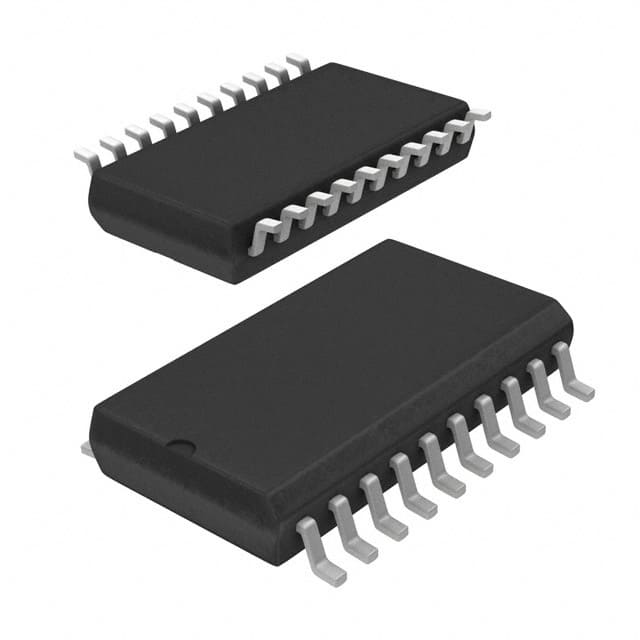Xem thông số kỹ thuật để biết chi tiết sản phẩm.

SN74AHC245QDWRG4
Product Overview
- Category: Integrated Circuit
- Use: Level Shifter/Transceiver
- Characteristics: High-Speed, Non-Inverting, 8-Bit Bidirectional Transceiver
- Package: SOIC (Small Outline Integrated Circuit)
- Essence: The SN74AHC245QDWRG4 is a high-speed, non-inverting, 8-bit bidirectional transceiver designed for voltage level shifting between different logic levels.
- Packaging/Quantity: Tape and Reel, 2500 pieces per reel
Specifications
- Supply Voltage Range: 2 V to 5.5 V
- High-Level Input Voltage: 0.7 x VCC to VCC + 0.5 V
- Low-Level Input Voltage: -0.5 V to 0.3 x VCC
- High-Level Output Voltage: VCC - 0.5 V
- Low-Level Output Voltage: 0.5 V
- Maximum Operating Frequency: 80 MHz
- Propagation Delay: 6 ns
- Operating Temperature Range: -40°C to 85°C
Detailed Pin Configuration
The SN74AHC245QDWRG4 has a total of 20 pins. The pin configuration is as follows:
- DIR (Direction Control)
- OE (Output Enable)
- A1 (Data Input/Output)
- A2 (Data Input/Output)
- A3 (Data Input/Output)
- A4 (Data Input/Output)
- A5 (Data Input/Output)
- A6 (Data Input/Output)
- A7 (Data Input/Output)
- A8 (Data Input/Output)
- GND (Ground)
- B8 (Data Input/Output)
- B7 (Data Input/Output)
- B6 (Data Input/Output)
- B5 (Data Input/Output)
- B4 (Data Input/Output)
- B3 (Data Input/Output)
- B2 (Data Input/Output)
- B1 (Data Input/Output)
- VCC (Supply Voltage)
Functional Features
- Bidirectional Data Transfer: The SN74AHC245QDWRG4 allows for bidirectional data transfer between two buses with different voltage levels.
- Non-Inverting Logic: The transceiver maintains the same logic polarity during data transmission.
- High-Speed Operation: With a maximum operating frequency of 80 MHz, it enables fast data transfer.
- Output Enable Control: The OE pin can be used to disable the outputs, allowing for easy control of data flow.
Advantages and Disadvantages
Advantages: - Supports voltage level shifting between different logic levels. - Non-inverting logic preserves the original signal polarity. - High-speed operation facilitates fast data transfer. - Output enable control provides flexibility in managing data flow.
Disadvantages: - Limited supply voltage range (2 V to 5.5 V). - Propagation delay of 6 ns may introduce slight delays in data transmission.
Working Principles
The SN74AHC245QDWRG4 operates by receiving data on one set of pins (A1-A8) and transmitting it to another set of pins (B1-B8). The direction of data flow is controlled by the DIR pin. When DIR is high, data flows from A to B, and when DIR is low, data flows from B to A. The OE pin can be used to enable or disable the outputs.
The transceiver uses a combination of CMOS and TTL technologies to achieve high-speed operation and non-inverting logic. It incorporates internal circuitry to handle voltage level shifting, ensuring compatibility between different logic levels.
Detailed Application Field Plans
The SN74AHC245QDWRG4 is commonly used in various applications that require voltage level shifting and bidirectional data transfer. Some of the typical application fields include:
- Microcontroller Interfacing: The transceiver facilitates communication between microcontrollers operating at different voltage levels.
- Bus Level Shifting: It enables data transfer between buses with different logic voltage levels, such as between 3.3V and 5V systems.
- Signal Translation: The SN74AHC245QDWRG4 can be used to translate signals between different logic families, such as CMOS and TTL.
Detailed and Complete Alternative Models
- SN74LVC245APW: Low-Voltage CMOS Octal Bus Transceiver
- SN74HCT245N: High-Speed CMOS Logic Octal Bus Transceiver
- SN74LVCH245ADBR: Low-Voltage CMOS Octal Bus Transceiver with 3-State Outputs
- SN74ACT245DW: Octal Bus Transceiver with 3-State
Liệt kê 10 câu hỏi và câu trả lời thường gặp liên quan đến ứng dụng SN74AHC245QDWRG4 trong giải pháp kỹ thuật
Sure! Here are 10 common questions and answers related to the application of SN74AHC245QDWRG4 in technical solutions:
Question: What is the SN74AHC245QDWRG4?
- Answer: The SN74AHC245QDWRG4 is a high-speed octal bus transceiver with 3-state outputs.Question: What is the purpose of the SN74AHC245QDWRG4?
- Answer: It is used to enable bidirectional level translation between different voltage domains in digital systems.Question: What is the maximum operating voltage for the SN74AHC245QDWRG4?
- Answer: The maximum operating voltage is 5.5V.Question: How many channels does the SN74AHC245QDWRG4 have?
- Answer: It has 8 channels, allowing bidirectional data transfer between two buses.Question: What is the maximum data transfer rate supported by the SN74AHC245QDWRG4?
- Answer: It can support data transfer rates up to 100 MHz.Question: Can the SN74AHC245QDWRG4 handle different voltage levels on its input and output sides?
- Answer: Yes, it can handle voltage translation between different voltage domains, such as 3.3V and 5V.Question: Does the SN74AHC245QDWRG4 have any built-in protection features?
- Answer: Yes, it has built-in ESD protection, which helps protect against electrostatic discharge events.Question: What is the power supply voltage range for the SN74AHC245QDWRG4?
- Answer: The power supply voltage range is from 2V to 5.5V.Question: Can the SN74AHC245QDWRG4 be used in both digital and analog applications?
- Answer: No, it is primarily designed for digital applications and may not be suitable for analog signals.Question: Are there any recommended external components or circuitry required for using the SN74AHC245QDWRG4?
- Answer: The SN74AHC245QDWRG4 typically does not require any external components for basic operation, but additional decoupling capacitors may be recommended for stable performance.
Please note that these answers are general and may vary depending on specific application requirements. It is always recommended to refer to the datasheet and consult with technical experts for accurate information.

